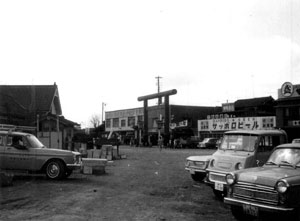公開日 2021年11月12日
Meiji, Taisho, and Showa Periods
Modern Japan at Dawn
The Edo shogunate collapsed and Japan was awakened after the isolation period which lasted over 200 years. Japan had to be transformed dramatically into a modern nation. Following the imperial edict to separate Shinto from Buddhism in 1868, there occurred anti-Buddhism campaigns in various places in Isehara. Temples and Buddhist statues were seriously damaged. Oyama-dera was not exceptional.
The Movement for the Freedom and People’s Rights became active nationwide calling for the opening of the parliament and establishment of the constitution in a rapidly changing social situation that people seldom experienced before. Shonansha was an organization which was led by Yamaguchi Sashichiro from Kami-Kasuya. It became the core of this movement in Kanagawa Prefecture doing remarkable activities to modernize villages under the slogan ‘People’s Freedom and Rights’.
In 1888, a law was enacted to organize municipalities, giving birth to Isehara and Oyama towns, and Takabeya, Hibita, Naruse, Ota, and Okazaki villages. The total population exceeded 17,000 and public facilities such as schools, post offices, and the Chamber of Commerce and Industry were established. In the following year when the Imperial Constitution was promulgated, Japan became Asia’s first constitutional country. The parliament was opened two years later, which fulfilled people’s longtime wish. The government, however, was not so stable from the late 1880s to 1890s. Under the threatening social situation, diplomatic relations with other countries were getting worse, leading Japan to the wars against China and Russia.
On the other hand, culturally, young, energetic writers and artists laid the foundation of Japanese modern culture. In Isehara the statues of the Healing Buddha Triad of Hojo-bo Temple were restored in 1901 under the supervision of Okakura Tenshin, who founded the Japan Art Academy. In 1900, Tsuboi Shogoro, president of the Tokyo Anthropology Society, visited Sannomiya to excavate groups of tumuli in the Nukubi and Shimoyato sites.
The Great Kanto Earthquake and the Second World War
A large number of people were killed or injured by the Great Kanto Earthquake in Isehara, too, in 1923. Isehara was restored remarkably from the earthquake. The Odakyu Train Line was opened in 1927 linking Isehara to Tokyo Metropolis. Commerce and business facilities were improved; traffic and telecommunication networks were developed centering around Tokyo. Literature, stage performing arts, and sports got mature.
However, the social environment gradually became more militaristic and then the Pacific War broke out. Oyama became the shelter for the evacuated children from Tokyo and Yokohama. Temples and shrines were told to submit the bronze bells for the military use. So many men were sent to the front from Isehara and about 800 of them were killed in the war.
After the war, people had to undergo hardship. People suffered from a serious shortage of food. They had very little food to eat, with the only clothes they wore. In Isehara, former two towns and four villages, except for Okazaki, were consolidated to start new Isehara Town in 1954. Then junior high schools were established, advanced farming was introduced, and roads were improved. The population of Isehara at that time was 26,000. The food situation got better. In 1956, former Okazaki Village was divided into two: one got annexed to Isehara, while the other, to Hiratsuka. Around the 1950s to the 1960s, Isehara Town put more importance on the development to meet the needs of the times, improving both National Route 246 and the Tomei Expressway, inviting manufacturing companies to build their factories, and constructing apartment complexes such as the one in Hachimandai.
The Birth of Isehara City
In the 1960s, Isehara began to be transformed into a city making the most of its location: within the greater metropolitan area with the traffic convenience, and at the Tanzawa mountain system with its great nature and a mild climate. Isehara has grown rapidly to be a modern city by opening the south entrance to Isehara Station, rezoning its surrounding areas, building an industrial park, expanding the central street which starts from Isehara Station’s north exit, and developing large-scale new residential areas such as Akanedai and Tsukimino. Isehara was incorporated as the 15th city in Kanagawa prefecture on March 1, 1971.
Isehara has been developing in a thriving Japanese economy. Isehara and its people have been changed a lot as many more people moved to this city, a bedroom community in the greater metropolitan area.
The drastic economic growth changed people’s lives as well. Technological innovations have produced a convenient society, while the traditional industries have been disappearing. Sericulture, smithery, and quarrying in Hinata are some examples. The old tools are now covered with dust. Local festivals and traditional events have been getting different little by little. Such changes occurred not only in Isehara but in all over Japan under the high economic growth.
Mt. Oyama, beautiful as always, has been watching quietly how our home town Isehara is transformed.

- In front of Isehara Station
Previous⇒Edo Period


